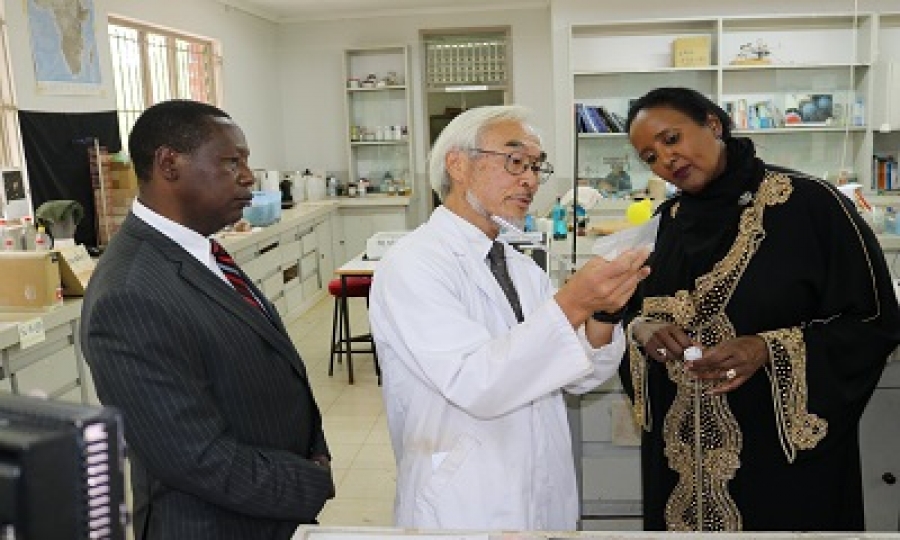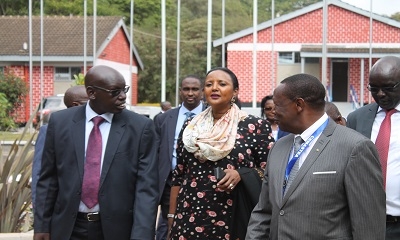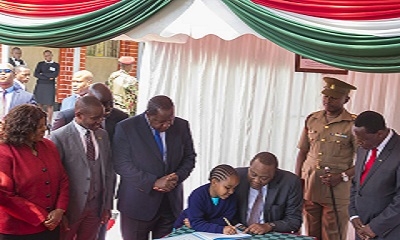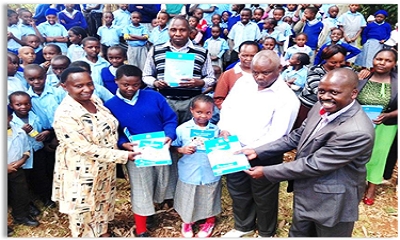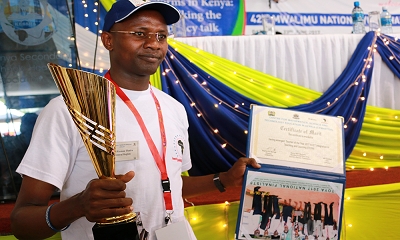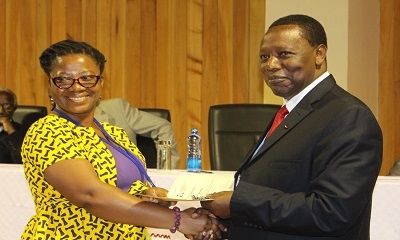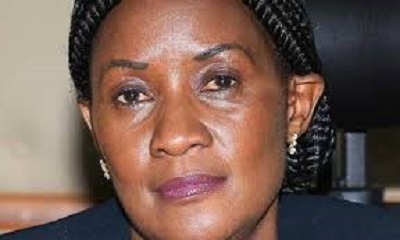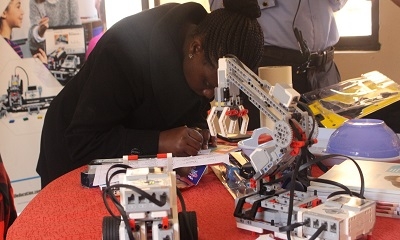CEMASTEA News 162
Children categories
article written by Winfred/CEMASTEA
During her first official visit to the Centre for Mathematics, Science and Technology Education in Africa (CEMASTEA), the Cabinet Secretary for Education Amb. (Dr.) Amina Mohammed, CBS, CAV, EGH congratulated CEMASTEA for the excellent work. She promised that the Ministry of Education wouldsupport the training programmes offered by the Centre.

Amb. (Dr.) Amina Mohammed, EGH, CAV signing the visitor’s book at CEMASTEA)
[Photo: Dan Orero/CEMASTEA]
She recapitulated that CEMASTEA training programmes being primarily on Mathematics, Science and Technology are in line with the government’s commitment to promote innovativeness, effectiveness, creativity and technology transfer which is supported by the constitution, the National Education Sector Plan of 2014-2018 and the Sessional Paper No. 2 of 2016, the Basic Education Act 2013, Science, Technology & Innovation Act 2013 and Vison 2030. The training programmes will promote Teacher Professional Development and improve skills of Mathematics and Science Teachers

Amb. (Dr.) Amina Mohammed, EGH, CAVwatering an Elgon Teak tree she planted during her official visit to CEMASTEA
[Photo: Dan Orero/CEMASTEA]
She stated that teachers need to go beyond the mere transfer of knowledge and instead equip learners with problem solving, creative and collaborative skills which will establish a connection between school work, work place, community and the global economy.

The CS, MoE and the Director CEMASTEA being taken through a demonstration by Prof. Ishikawa at the Innovations Lab-CEMASTEA
[Photo: Dan Orero/CEMASTEA]
She was impressed with the exhibitions and innovations that the students showcased during her visit and confirmedthat the focus on STEM education is beginning to bear fruits.

The CS MoE, Director CEMASTEA and the CEMASTEA staff being taken through a robotic demonstration by students from Jamhuri High School
[Photo: Dan Orero/CEMASTEA]
She remarked that the need to commercialize these innovations would create job opportunities and there is a need to match the innovations with what the job market requires.

Amb. (Dr.) Amina Mohammed, EGH, CAV speaking during her visit to CEMASTEA
[Photo: Dan Orero/CEMASTEA]

The CS MoE receives a crate of bottled water distilled by students from St. Albert’s Ulanda Girls’ High school following the STEM trainings by CEMASTEA
[Photo: Dan Orero/CEMASTEA]
She challenged the teachers, students and stakeholders to positively take the STEM programmes offered by the Centre.

Amb. (Dr.) Amina Mohammed, EGH, CAV (centre) poses for a group photo with students and teachers from Olekajuado High School
[Photo: Dan Orero/CEMASTEA]

Amb. (Dr.) Amina Mohammed, EGH, CAV (centre) poses for a group photo with students and teachers from St. Alberts Girls UlandaHigh School
[Photo: Dan Orero/CEMASTEA]

Amb. (Dr.) Amina Mohammed, EGH, CAV (centre) poses for a group photo with students and teachers from St Mary’s Ngarariga High School
[Photo: Dan Orero/CEMASTEA]

Amb. (Dr.) Amina Mohammed, EGH, CAV (centre) poses for a group photo with students and a teacher from Jamhuri High School
[Photo: Dan Orero/CEMASTEA]

Amb. (Dr.) Amina Mohammed, EGH, CAV (centre) poses for a group photo with students from Buru Buru Girls High School
[Photo: Dan Orero/CEMASTEA]

Amb. (Dr.) Amina Mohammed, EGH, CAV (centre) poses for a group photo with CEMASTEA staff
[Photo: Dan Orero/CEMASTEA]
Centre for Mathematics, Science Technology Education in Africa (CEMASTEA) is today honoured to host on behalf of the Ministry of Education, the CS Education Amb. (Dr) Amina Mohammed. E.G.H, CAV. The meeting was an extensive briefing session where she was taken through the policies, programs and initiatives the ministry is undertaking.

Mr. Stephen Njoroge, HSC, Director CEMASTEA welcomes Amb. (Dr.) Amina Mohammed, EGH, CAV for a meeting at CEMASTEA, Karen

Amb. (Dr.) Amina Mohammed, EGH, CAV signing the visitors book at CEMASTEA

Left Dr. Belio Kipsang MOE, Amb. (Dr.) Amina Mohammed, EGH, CAV and Mr. Stephen Njoroge, HSC, Director CEMASTEA at CEMASTEA, Karen

Seated from (far Left) Mr. Simon Kavisi, Deputy Commission Secretary, (TSC) (2nd left) Mr. Stephen Njoroge, Director, CEMASTEA, (3rd Left) Dr. Belio Kipsang PS Basic Education, Amb. (Dr.) Amina Mohammed, EGH, CAV, Hon. Kachapin, Chief Administrative Secretary, Prof Japheth Ntiba PS University Education and Research (standing) members of staff from state department of early learning and basic education at CEMASTEA, Karen
On Friday January 5, 2018, Centre for Mathematics, Science and Technology Education in Africa (CEMASTEA) was honoured to host His Excellency Hon. Uhuru Kenyatta, CGH, President and Commander in Chief of the Defense Forces of the Republic of Kenya as he presided over the Commissioning of Core Course Books for Secondary schools. The function was spearheaded by the Ministry of Education.

His Excellency the President Uhuru Kenyatta guides Domita Nyambura, a pupil from Karen C Primary to sign the visitor’s book at CEMASTEA Karen
Prof. Colletta A. Suda(left) CBS, Principal Secretary, State Department for University Education, Mr. Joe Mucheru (second left) CS Information, Communication and Technology (ICT), Dr Belio Kipsang, Principal Secretary Ministry of Education, Dr. Fred Matiang’i Cabinet Secretary Ministry of Education and (far right) Mr. Stephen M. Njoroge, HSC Director CEMASTEA

His Excellency the President Uhuru Kenyatta, seated with from left: Dr. Diana Mwinzi, Principal Secretary Vocational & Technical Training, Prof. Colletta A. Suda, CBS, Principal Secretary, State Department for University Education, Dr. Fred Matiang’i, CS, Ministry of Education, Mr. Joe Mucheru, CS Information, Communication and Technology (ICT), Dr. Richard Belio Kipsang’, Principal Secretary Ministry of Education, Science and Technology during the textbooks launch at CEMASTEA, Karen

His Excellency the President Uhuru Kenyatta sharing a light moment with Mr. Wilson Sossion KNUT Secretary General, Prof. George Magoha, Chairperson KNEC and Dr. Fred Matiang’i, Cabinet Secretary Ministry of Education during the launch of textbooks at CEMASTEA Karen

His Excellency the President Uhuru Kenyatta flagging off the textbooks during the launch at CEMASTEA, Karen

His Excellency the President Uhuru Kenyatta handing over textbooks to pupils from Karen C Primary School during the launch at CEMASTEA, Karen
Pupils drawn from Kanjora Primary School, D.E.B Kahiga-ini Primary School, Karuna-ini Primary School and Gathathi-Ini Primary School in Nyeri County got a warm treat from the five member team from CEMASTEA when they visited their schools to donate books on peace education. Peace Education was the theme for the Corporate Social Responsibility (CSR) held from Thursday January 18, 2018 to Friday January 19, 2018.
Led by Mrs. Beatrice Macharia, the Deputy Coordinator Training, CEMASTEA and Mr. Philip Maate, the Deputy Dean Physics Education department, CEMASTEA; the team spent the two days interacting and engaging the pupils, parents and teachers in educational and motivational talks before awarding the pupils with the Peace Education story books including the teachers’ guide which were donated by the Ministry of Education (MoE) through Mrs. Macharia’s initiative and the Communication Department of CEMASTEA with the great support from the Director CEMASTEA, Mr. Stephen M. Njoroge, HSC.

CEMASTEA Book Donation: Pupils from Karuna-ini Primary School and their teachers receiving books from Mrs. Beatrice Macharia-Deputy Cordinator, TrainingCEMASTEA (left) and Mr. Philip Maate, Deputy Dean Physics CEMASTEA (right)[Photo: Charles Karani]
The aim for donating the books was to sensitize the pupils, teachers and the parents on the importance of Peace Education that has also been incorporated in the new curriculum.
Speaking to the parents, Mrs. Macharia emphasized that the home environment affects the school environment, therefore there is need to create a good environment for the children at home since this will see them through their other learning environments. She encouraged the teachers to be more innovative in teaching and learning to ensure that the performance is improved.

Teachers from D.E.B Kahiga-ini Primary school in Nyeri County receiving guidance for ‘Teacher Activity Book’ on Peace Education from Mrs. Beatrice Macharia (right) and Mr. Philip Maate (left) during the book donation by CEMASTEA. [Photo: Charles Karani]
On the other hand, Mr. Maate encouraged both the teachers and the parents on the importance of team work. He also gave them an illustration paraphrasing it from the bible in Colossians 3:23 on the need to take responsibility.
The pupils were encouraged to work hard in their studies and not to indulge in behaviours that will lead them into bad habits like drug abuse. They were also told to embrace peace in their lives and learning.
The CSR is among the activities and projects lined up in the CEMASTEA Calendar this year.
Dan Orero/CEMASTEA
This email address is being protected from spambots. You need JavaScript enabled to view it.
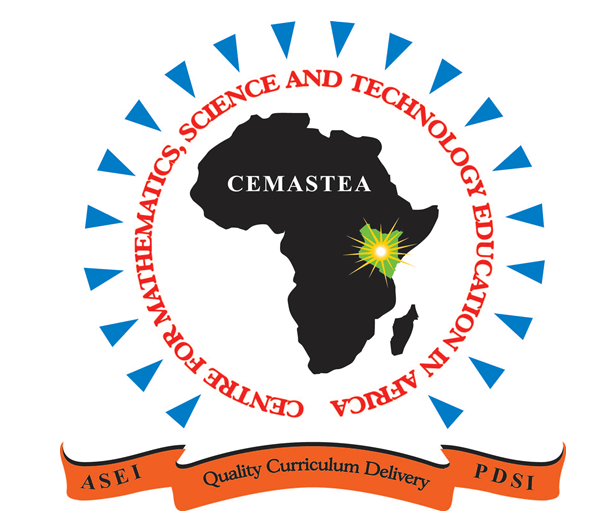
Centre for Mathematics, Science and Technology Education in Africa (CEMASTEA)
TEACHING AND LEARNING DURING COVID-19 PANDEMIC: INSIGHTS FROM SELECTED MATHEMATICS AND SCIENCE TEACHERS IN KENYA
COVID-19 pandemic has had devastating effects on all spheres of life and the education sector has not been spared. The disease was first reported in China in December 2019. By January 2020, it had become clear that COVID-19 was raising health concerns including the fact that it was highly contagious with a potential to cause death for some of the infected persons. Thus, the World Health Organisation (WHO) asked countries to take precautionary measures to ensure containment of the disease. The first case of COVID-19 was reported in Kenya on 13th March 2020 and two days later the President directed all learning institutions to close as a containment measure to curb the spread of the disease. Even though the closure of schools did not mean the end of education, it temporarily halted the face-to-face interactions between teachers and students.
To ensure continuity of learning following the schools closure, the Ministry of education (MOE) drafted the Kenya basic Education COVID-19 Emergency Response Plan (MOE, 2020), to guide the process. For example, through the plan, the MOE committed to strengthen the Kenya Education Cloud at the Kenya Institute of Curriculum Development (KICD) to ensure easy access to digital content by teachers and students. The MOE also tasked KICD to ensure provision of Radio and TV broadcasts on a timely and predictable manner including broadcasting through community radio channels. However, it was not clear how teachers would navigate the process of supporting learning through remote means as well as the kind of support they needed to be effective and successful in their work. This concern arose from the fact that up until the emergence of COVID-19 pandemic most of the teaching had been face-to-face.
This study which involved 472 SMASE Secondary school county trainers and 3718 secondary school mathematics and science teachers trained through CEMASTEA in 2020 was conducted to give insights into this issue. The study sought to (1) identify ways in which COVID-19 affected teaching and learning in secondary mathematics and science in Kenya (2) determine mathematics and science teachers’ perspectives about online teaching and learning (3) determine the ICT tools and platforms, sources of information, and support that enabled mathematics and science teachers to continue supporting learners during the COVID-19 pandemic (4) identify areas of capacity development for mathematics and science teachers to continue teaching during COVID-19 pandemic. To address these objectives the study adopted a descriptive survey methodology and utilised questionnaires to collects data.
The findings of this study show that teaching and learning was affected in three main ways as follows (1) disruption to teaching and learning (2) shift from face-to-face to remote teaching and learning, and (3) disruption to activities related to teaching and learning. As far as disruption to teaching and learning was concerned, the respondents noted that face-to-face interactions with student were not possible as a result of COVID-19 pandemic. They were concerned about students missing such interactions with the concern being greater for the Form Four students because of being in a candidate class and therefore expected to sit KCSE later in the year. It also emerged that despite this concern for students missing such interactions, majority of the respondents took more than four weeks to reach out to support students’ learning.
Indeed only about 40% of the respondents took the steps to reach out to students and support their learning utilising mainly telephone and specifically WhatsApp. The low percentage of respondents who made an attempt to reach out to students could be attributed to their perception about remote teaching and learning where majority of them did not believe that there could be effective teaching and learning through online platforms. This study also revealed that a teacher’s confidence to enact teaching through online platforms is a factor that affects whether or not a teacher engages students to learn through online platforms. The Multiple Logistic Regression Model applied in this study showed that respondents who were somehow confident or not confident at all to conduct teaching through online platforms had a relatively high likelihood of not conducting lessons during the pandemic period compared to those who were confident.
It also emerged that COVID-19 disrupted the routine of activities related to teaching and learning in terms of time spent on these activities. On average, between 43% and 45% of respondents spent less than two hours on teaching and other activities related to teaching such as planning lessons; reviewing lesson notes; assessing students’ learning and revising work already covered with students.
Regarding ICT tools, it emerged that the respondents were aware of a variety of ICT tools that could be deployed to support students’ learning during COVID-19 pandemic. The tools include hardware such laptops, mobile phones, CD-ROMs, Television, radio as well as platforms such as Google Classroom, WhatsApp, Facebook and sources of e-content form the internet through search engines such as Google, Firefox and Microsoft Edge. Despite, this high extent of awareness, the respondents’ deployment of these tools in supporting learning during COVID-19 was low for all the tools except WhatsApp which had the highest reported incidents of use. Internet connectivity (both in terms of cost and coverage) was the single factor cited most by respondents as a hindrance to the deployment of the tools to support students’ learning during COVID-19 pandemic.
All in all, the respondents acknowledged receiving support from several stakeholders aimed at continuity of learning during COVID-19 pandemic. The stakeholders who played a key role in this process included the MOE, Ministry of Health, TSC, KICD, CEMASTEA, school administration and County Governments. The support provided ranged from provision of information about COVID-19 (i.e., the need to keep and stay safe), and payment of salaries to capacity development in the use of some of the learning management systems (LMS), and provision of e-learning materials and internet bundles to access the materials.
This study concludes that, only a limited number of mathematics and science teachers reached out to their students to support their learning during COVID-19 pandemic. This was mainly due to barrier of accessibility and cost of ICT tools on the part of students. But also, the teachers’ perception about remote learning and their confidence to enact teaching through online platforms played a role in this. The study recommends that there should be sustained teacher professional development especially in the area of remote or online teaching and learning to equip the teachers with the requisite skills to support learners during circumstances that lead to prolonged school closures. Furthermore, ICT tools that include devices such as such as Smart phones, tablets, laptops, radio, TV and internet sets as well as electricity are enablers of remote or online learning. These resources need to be made available to all teachers and students to enable implementation of remote or online learning. This can only happen through a concerted effort of all stakeholders (i.e.,, BOM, school administration, and parents) including multi-agency support through various ministries such as MOE, ICT and energy. Specifically parents on their part are required to provide ICT tools and related resources such as internet bundles to ensure continuity of learning in circumstances leading to prolonged school closures. But more importantly, the role of parents in home schooling needs to be explored given the need for them to play a role also in guiding and supporting their children to gain meaningfully from the experiences of remote or online learning.
Congratulations to Mr. Paul Kamau Thairu; i -TOYA winner following his HSC award (Civilian Division) by His Excellency President Uhuru Kenyatta.
i -TOYA competition 2017 was a collaboration between CEMASTEA,TSC, eKitabu and KESSHA.
Education: City- based Centre boosting science teaching in Africa
By: Joe Ombuor
October 32017
Nairobi- based Centre for Mathematics, Science and Technology in Africa has trained hundreds of science, technology, engineering and mathematics teachers from across the continent the institution’s Director Mr Stephen Njoroge has said.
He said the skills acquired had trickled down to thousands of others and their students as those trained become trainer of their colleagues with the end result of improved performance.
The director spoke when he presented certificates to 43 participants from seven African countries at the end of a two- week training session organized together with Kenya’s Ministry of Education and the Japan International Co-operation Agency.
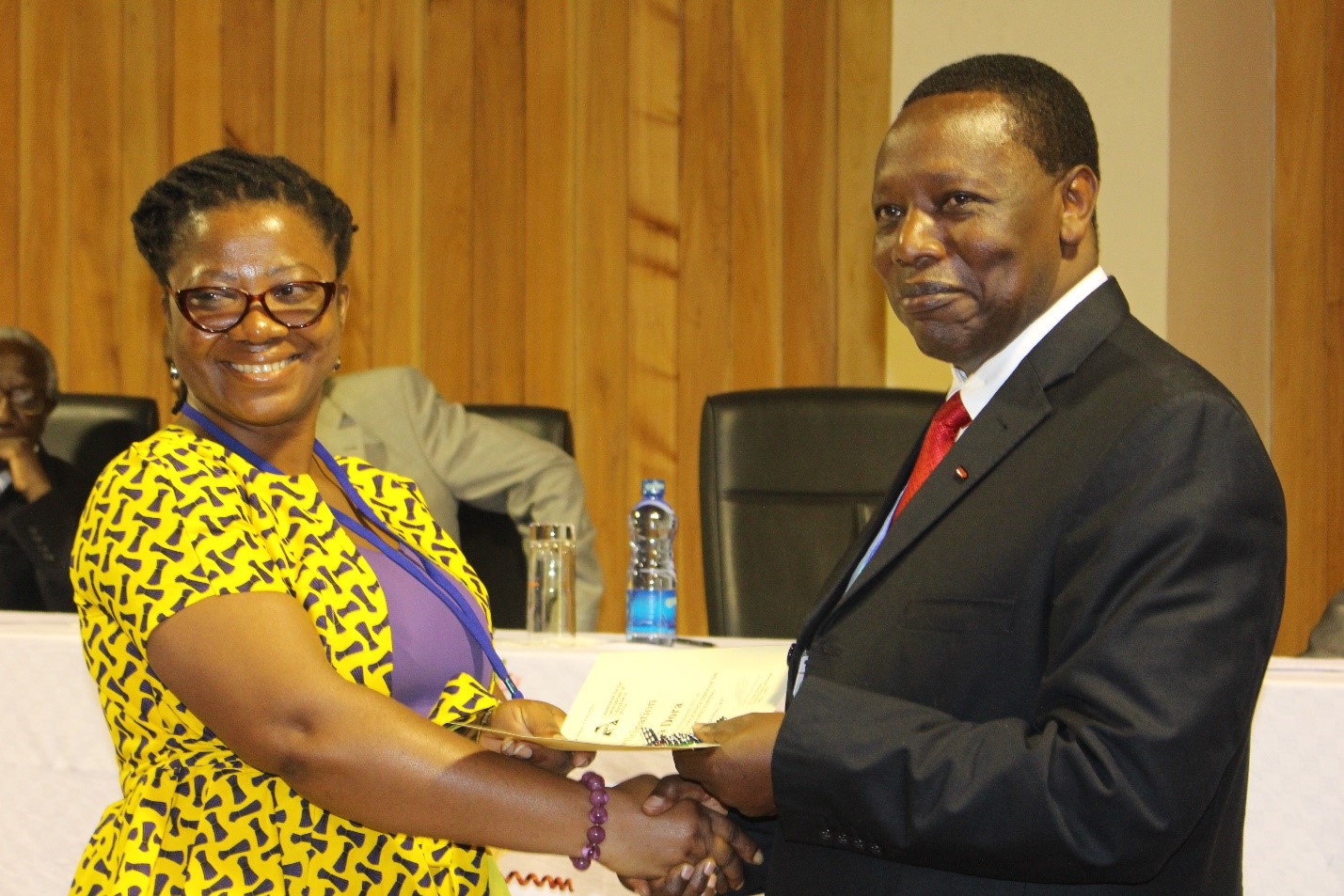
Mr. Stephen Njoroge (right)Director, Centre for Mathematics, Science and Technology Education in Africa, presents a certificate to a participant. [Dan Orero/CEMASTEA]
By: OumaWanzala
September 24 2017
The Teachers Service Commission has said there is need for regular training of practicing teachers in Kenya and other countries in the region.
TSC chief executive Nancy Macharia, said this will enable teachers to continuously equip themselves with opportunities to update and improve their knowledge and teaching techniques.
“This will greatly impact how they deliver lessons and effectively offer and education that is not only relevant but focused on real world problems,” said Mrs. Macharia
Ms. Macharia made the remarks at the Centre for Mathematics, Science and Technology Education in Africa during a training of mathematics and science teachers from seven African countries in the region on in Nairobi.
The two-week training will end next week. “I am delighted therefore to see continental efforts being made to improve the professional practice of teachers that will enhance the quality of education and learner achievement, “added Ms. Macharia.
Mrs. Macharia said the in-service education and training will increase teachers ‘capacity for a deeper understanding of the continent, how students learn and a broaden comprehension of clear- cut teaching skills and strategies that ultimately result in student learning.
Association for the Development of Education in Africa senior Finance and budget office Foday Kargbo underscored the role of governments and development partners in achieving both continental blue prints and global agenda
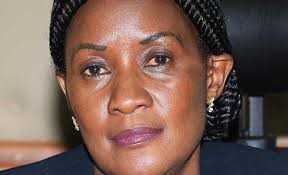
Mrs. Nancy Macharia, CEO Teachers Service Commission.[File]
By: Augustine Oduor
August 26 2017
The government is equipping selected secondary schools with modern learning tools that will make Mathematics and Science easy and enjoyable. Each of the 102 schools selected in every county will get modern equipment for Biology, Chemistry, Mathematics, Physics and Information and Communication Technology.
The items are part of the Science, Technology, Engineering and Mathematics (STEM) project being implemented by the Ministry of Education. The programme is being rolled out by the Centre for Mathematics, Science and Technology Education in Africa (CEMASTEA). At least two schools were selected in each of the 47 counties for the pilot stage.
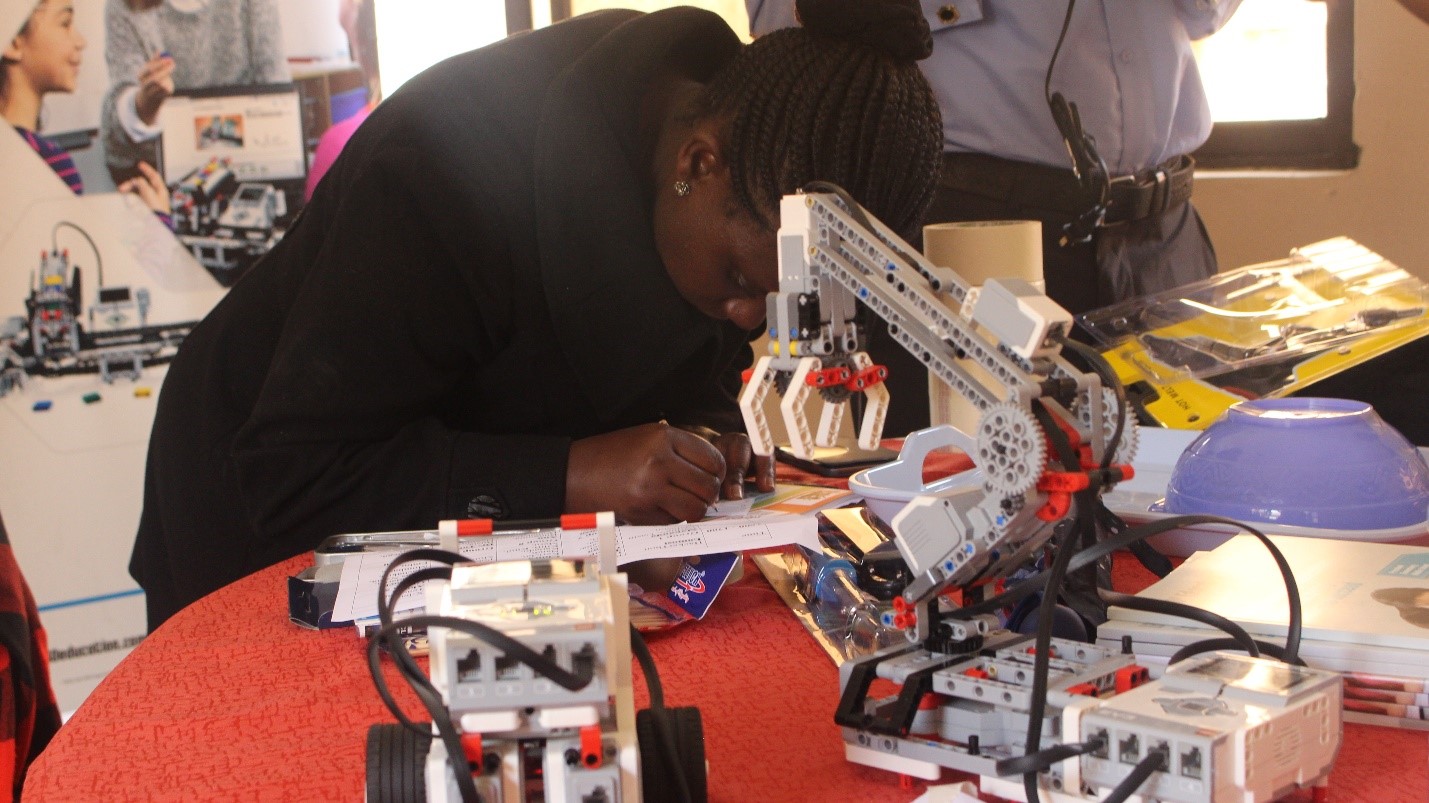
Esther Nyambura ICT officer CEMASTEA interacting with robots during The STEM Sensitization workshop. [Dan Orero/CEMASTEA]
The Ministry of Education initiated the Stem Model Schools intervention programme to enhance learners’ capability in Science and Mathematics, CEMASTEA Director, Mr Stephen Njoroge said each of the selected schools will get laptops, LCD projectors, digital cameras, white-boards, light microscopes, photometers, biological models, and preserved specimens. Also, to be provided are thermometers and stop watches to make learning cool. Mr Njoroge said the Government has already started to procure the modern learning equipment
“We are going to provide modern Chemistry, Physics And Biology leaning materials to schools at an estimated cost of Sh54 million,” said Mr Njoroge
CEMASTEA was allocated Sh32 million in the 2016/2017 financial year to implement the project. In the 2017/2018 financial year, the centre has been allocated Sh58 million. The centre has already developed a Stem module and is conducting training of teachers and sensitization of stakeholders. The training will end this month, Mr Njoroge said more than 306 teachers have undergone one-week training ahead of the roll out. The training was conducted in Nakuru, Eldoret, Mombasa, Nyeri, Embu, Kakamega, Kisumu, and Thika.



